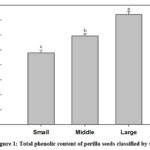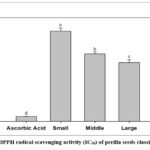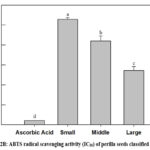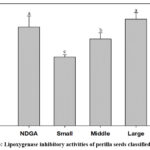Introduction
Perilla (Perilla frutescens L.) is widely cultivated in East Asia, and its seeds are valued for their nutritional and functional properties, making them a valuable ingredient in both food and medicinal products. The cultivation of P. frutescens has also expanded to regions such as the United States, South Africa, Egypt, and Russia.1–3 P. frutescens is cultivated both as a seed oil crop and as a leafy vegetable. Perilla leaves are rich in anthocyanin pigments and flavonoids, including quercetin, β-carotene, luteolin, caffeic acid, and rosmarinic acid.4,5 Caffeic acid, a polyphenolic compound, is known for its antioxidant and anticarcinogenic properties, including its role in reducing oxidative stress and inhibiting aflatoxin production.6 Rosmarinic acid, an ester of two molecules derived from caffeic acid, helps remove reactive oxygen species (ROS) produced in the body, which may contribute to aging and various diseases.7 Additionally, it exhibits anti-mutagenic, antiviral, and anti-cancer activities. Perilla oil is known for its rich in α-linolenic acid and omega-3 fatty acids, both of which are beneficial to health.8,9 Perilla seeds are abundant in α-linolenic acid, which may help lower blood cholesterol levels and helps prevent cardiovascular diseases.10 However, variations in the quality of perilla seeds can lead to significant differences in the chemical composition and antioxidant activity of perilla oil. Additionally, perilla oil contains various polyphenols and antioxidant compounds that reduce oxidative stress, contributing to its anti-aging and anti-cancer effects.11 However, these functional components can vary greatly depending on seed quality and the extraction methods used. In addition, perilla oil extracts from different varieties differ significantly in fatty acid composition and antioxidant activity.12
Previous studies have examined the impact of variety, cultivation environment, and post-harvest processing methods on the quality of perilla oil.6,11 Moreover, various studies have examined the impact of different extraction methods on the chemical characteristics and stability of perilla oil.13–15
The effects of perilla variety and cultivation environments on the composition of fatty acid and antioxidant activity of perilla oil have also been documented.12,16 Selecting high-quality perilla seeds for oil production may enhance the nutritional properties of the oil. While studies have shown that seed size affects seed germination and growth, current research comparing the bioactive compounds and physiological activities based on seed size remains insufficient.17,18
The aim of this study was to classify perilla seeds by size and analyze their fatty acid profiles, proximate components, and antioxidant and anti-inflammatory activities to identify potential nutritional and functional differences among seed-size categories.
Materials and Methods
Materials
Perilla (Perilla frutescens var. japonica) plants were cultivated and harvested in Cheongsonggun, Gyeongsangbuk-do, Korea, in September 2023. After harvesting, seeds were sorted by size. Seed size was measured by determining the diameter of individual seeds using a digital caliper with an accuracy of 0.01 mm. A representative sample of seeds was selected, and the measurements were taken across the longest axis of each seed. The average size for each category was calculated based on these measurements. Classified seeds were washed and dried prior to analysis. DPPH (2,2-Diphenyl-1-picrylhydrazyl) and ABTS (2,2′-azino-bis(3-ethylbenzothiazoline-6-sulfonic acid) were obtained from Sigma-Aldrich (St. Louis, MO, USA). The lipoxygenase inhibitor-screening kit for the anti-inflammatory activity assay was procured from Cayman Chemical (Ann Arbor, MI, USA).
Sample Preparation
The seeds used in the experiment were measured for size and weight, resulting in a size range of 1.18–2.5 mm and a weight range of 1.6–6.0 mg. Thus, seeds were classified into three categories: small (1.18–1.76 mm, 1.6–3.5 g), medium (1.77–1.97 mm, 3.5–5.0 g), and large (1.98–2.46 mm, 5.0–6.0 g).
Analysis of Bulk Density and Seed Volume
The bulk density of perilla seeds was determined using the formula D=M/VD = M / VD=M/V, where DDD represents bulk density (g/L), MMM is the weight of the seeds in a full container (g), and VVV is the volume of the container (L). In this study, a one-liter container was used. Bulk density was recorded in g/L, and to express it in kg/m³, the value was multiplied by 1,000. Seed volume was determined by calculating the number of seeds per gram of sample. To measure this, a 1g sample of perilla seeds was carefully weighed, and the individual seeds within the sample were manually counted. The resulting value represents the number of seeds per gram (seeds/g), providing an indication of seed size and density
Proximate Analysis
Moisture content was measured following AOAC methods by oven-drying the samples at 105°C, while ash content was determined by incinerating the samples in a muffle furnace at 550°C. Crude protein was analyzed using the Kjeldahl method (VAPODEST500, Gerhardt), and crude lipid content was determined by Soxhlet extraction (Soxtherm, Gerhardt). Carbohydrate content was calculated by subtracting the values obtained for moisture, ash, crude lipid, and crude protein from 100%.
Fatty Acid Composition
Following AOAC methods, the extracted fatty acids were derivatized into fatty acid methyl esters (FAME) using BF3/MeOH (14% boron trifluoride). FAME were analyzed using gas chromatography (Agilent 7890A GC, Agilent Technologies, USA)) with an SP-2560 column (100 m × 0.25 mm × 0.2 µm film thickness, Sigma-Aldrich) and a flame ionization detector. The injection port was set to 225°C, while the detector temperature was maintained at 285°C. Nitrogen was used as the carrier gas at a flow rate of 0.75 mL/min, with 1 µL of samples injected at a split ratio of 200:1. The oven temperature program began at 100°C, held for 4 minutes, then increased to 240°C at a rate of 3°C/min, and maintained for 15 minutes. Fatty acids were identified by comparing them with FAME standards (F.A.M.E. Mix, C4-C24, 18919-1amp, Sigma-Aldrich).
Total Phenolic Compounds
The Folin–Ciocalteu method19 was used to assess the total phenolic content of perilla seeds, with calculations performed based on a standard curve of gallic acid. The results were represented as micrograms (μg) of gallic acid equivalent (GAE mg) per gram of sample dry weight.
DPPH Radical Scavenging Activity
DPPH radical scavenging activity was assessed using a modified Blois method.20 A 90 µL DPPH solution was combined with 10 µL of each sample and incubated at 37 ℃ for 30 minutes. Absorbance was then recorded at 515 nm using a UV/Visible spectrophotometer (Perkin Elmer, Waltham, MA, USA). Each experiment was conducted in triplicate, and ROS scavenging activity was expressed as a percentage (%) using the formula.
DPPH radical scavenging activity (%) = (Absorbance of blank – Absorbance of sample) / Absorbance of blank × 100.
ABTS Radical Scavenging Activity
The ABTS radical cation method21 was modified to assess the free radical-scavenging activity of pure chemical compounds. To prepare the ABTS reagent, 5 mL of 7 mM ABTS was mixed with 88 μL of 140 mM potassium persulfate, and the mixture was kept in the dark at room temperature for 16 hours to generate free radicals. The reagent was then diluted with water at a ratio of 1:44 (v/v). For evaluating scavenging activity, 100 μL of the ABTS reagent was combined with 100 μL of the sample and incubated at room temperature for 6 minutes. Post-incubation, absorbance was measured at 734 nm, with 100% methanol used as a control. The ABTS scavenging activity was calculated using the following formula
ABTS radical scavenging activity (%) = (Absorbance of blank – Absorbance of sample) / Absorbance of blank × 100.
Lipoxygenase Inhibitory Activity
Lipoxygenase(LOX) inhibitory activity (anti-inflammatory activity) was determined using a LOX inhibitor-screening assay kit. Nordihydroguaiaretic acid (NDGA), which served as the standard LOX-inhibitory and anti-inflammatory compound, was used as a positive control. Initially, 15-LOX (90 μL) and the test samples (10 μL) were added to individual wells of a 96-well plate. The reaction was initiated by adding arachidonic acid (10 μL), which serves as a substrate for LOX, to each well, followed by incubation on a shaker for 5 minutes. To terminate the reaction, 100 μL of chromogen was added to each well. The hydroperoxide formed from arachidonic acid by 15-LOX was quantified by measuring absorbance at 500 nm using UV spectroscopy. The LOX inhibitory activity (%) was calculated using the manufacturer’s protocol: (C−T)/C × 100, where C and T correspond to the enzyme activity without and with the test samples, respectively.
Statistical Analysis
All experimental values are expressed as mean±standard deviation (mean ± SD). Statistical comparisons were performed using IBM SPSS 22 (IBM, Armonk, NY, USA). One-way analysis of variance (ANOVA) was employed for comparisons among experimental groups, and Tukey’s test was conducted as a post hoc analysis to identity significant difference between individual groups. A significant level of p<0.05 was used as the criterion for statistical significance.
Results and Discussion
Sample Preparation
The proportions of small, medium, and large perilla seeds in the total sample were 27%, 45%, and 28%, respectively. The average size, weight, bulk density, and volume of the classified seeds are presented in Table 1.
Table 1: Classification of Perilla seeds according to sizes.
|
Small |
Medium |
Large |
|
|
Size (mm) |
1.26* ± 0.02c | 1.66 ± 0.03b | 2.18 ± 0.04a |
| Weight (g) | 2.10 ± 0.17c | 3.48 ± 0.14b |
5.42 ± 0.08a |
|
Bulk density (g/L) |
687 ± 5.8c | 744 ± 9.7b | 800 ± 14.2a |
| Seed Volume (seeds/g) | 302,571 ± 659a | 218,823 ± 861b |
147,600 ± 987c |
*Data are means ± SD (n = 3).
Even under identical cultivation conditions, seed size and weight varied by up to two and five times, respectively. We investigated the characteristics of perilla seeds based on size differences.
Proximate Analysis
Table 2 summarizes the analysis of the general components of perilla seed-size groups. Moisture contents of small, medium, and large seeds were 4.8, 4.3, and 3.9%, respectively. Protein contents were 21.2, 20.3, and 19.1%, indicating similar levels across all samples. Fat content in large seeds was 48.3%, slightly higher than in medium (41.2%) and small (38.4%) seeds. Ash content was also slightly higher in large seeds. Previous studies have reported crude fat content of perilla seeds ranging from 35–45%.8,12,22 Our results indicate that large seeds exhibit a higher crude fat content within this range, while also containing lower moisture, protein, and carbohydrate compositions compared to smaller seeds. Although crude fiber was not determined in this study, these findings suggest that seed size influences various aspects of seed quality, not limited to fat composition alone.
Table 2: Proximate composition of perilla seeds.
|
General Nutrients (%) |
Seed size | ||
|
Small |
Medium |
Large |
|
| Moisture | 4.8 ± 0.03a | 4.3 ± 0.02b |
3.9 ± 0.01c |
|
Protein |
21.2 ± 0.24a | 20.3 ± 0.09b | 19.1 ± 0.04c |
|
Fat |
38.4 ± 0.38c | 41.2 ± 0.35b |
48.3 ± 0.62a |
| Ash | 2.7 ± 0.04c | 2.9 ± 0.01b |
3.1 ± 0.01a |
|
Carbohydrate |
32.9 ± 0.21a |
31.3 ± 0.35b |
25.6 ± 0.29c |
*Data are means ± SD (n = 3).
Fatty Acid Composition
Larger perilla seeds displayed the highest total fatty acid content (48%), with a peak in unsaturated fatty acids (92.95%) compared to medium and small seeds. Specifically, α-linolenic acid, known for its health benefits, was over 10% higher in large seeds than in small seeds, highlighting the nutritional advantage of larger seeds in terms of ω-3 fatty acids. We hypothesize that the higher fatty acid content in larger seeds may be due to greater storage capacity and resource allocation, as larger seeds often accumulate more lipids and other nutrients during development compared to smaller seeds. The average linoleic acid and unsaturated fatty acid contents in perilla seeds are reportedly 64% and 92%, respectively.12 α-Linolenic acid reportedly provides protective effects against neuronal cell death and can alleviate cellular apoptotic stress responses in myocardial cells.23,24
Table 3: Fatty acid profile of perilla seeds.
|
|
Fatty acids (%) | Seeds | ||
|
Small |
Medium |
Large |
||
|
Saturated fatty acids |
Palmitic acid |
6.32 ± 0.07b | 6.47 ± 0.02a |
4.93 ± 0.01c |
|
Stearic acid |
3.44 ± 0.01a | 2.45 ± 0.09b |
2.11 ± 0.04c |
|
| Total | 9.76 ± 0.04a | 8.93 ±0.13b |
7.04 ±0.22c |
|
|
Unsaturated fatty acids |
Oleic acid |
14.7 ± 0.17a | 14.05 ± 0.52a | 11.76 ± 0.06b |
| Linoleic acid | 13.29 ± 0.31a | 13.69 ± 0.42a |
11.63 ± 0.39b |
|
|
α -Linolenic acid |
62.25 ± 1.27b | 63.32 ± 0.95b | 69.55 ± 0.76a | |
| Total | 90.24 ± 0.54b | 91.07 ± 0.42b |
92.95 ± 0.52a |
*Data are means ± SD (n = 3).
Total Phenolic Content and Antioxidant Activity
Large seeds exhibited the highest polyphenol content at 147.5 GAE µg/g, followed by medium (118.7 GAE µg/g) and small seeds (96.1 GAE µg/g), with an observed difference between small and large seeds (Figure 1). Consistent with these findings, Russian perilla seeds reportedly have an average total phenol content of 112.54 µg GAE, whereas Korean perilla seeds have an average of 107.54 µg GAE.12 The accumulation of ROS in the body leads to oxidative stress, which, in turn, contributes to various diseases. Consequently, research has focused on natural materials with free radical-scavenging abilities to prevent cell damage. Therefore, we investigated the antioxidant activity of perilla seed-size groups by evaluating their DPPH and ABTS radical scavenging activities (Figure 2). Both DPPH and ABTS radical scavenging activities exhibited a concentration-dependent increase across all seed-size samples. The IC50 values for large, medium, and small perilla seeds in the DPPH assay were 79.5, 91.2, and 121.8 µg/g, respectively. In the ABTS assay, the IC50 values were 54.3, 84.1, and 105.8 µg/g, respectively. The antioxidant activity of large seeds was 1.5–2-fold higher than that of small seeds. Perilla seeds reportedly contain various antioxidants, such as rosmarinic acid, caffeic acid, vanillin, β-carotene, and β-tocopherol, in addition to fatty acids25. Although perilla oil is vulnerable to rancidity owing to its high unsaturated fatty acid content, producing oil from perilla seeds with high antioxidant activity may help prevent rancidity.
 |
Figure 1: Total phenolic content of perilla seeds classified by size. |
Results are show as mean±SD. Bars with different small case letters indicate significant differences between them at p<0.05
 |
Figure 2A: DPPH radical scavenging activity (IC50) of perilla seeds classified by size. |
Results are show as mean±SD. Bars with different small case letters indicate significant differences between them at p<0.05
 |
Figure 2B: ABTS radical scavenging activity (IC50) of perilla seeds classified by size. |
Results are show as mean±SD. Bars with different small case letters indicate significant differences between them at p<0.05
Anti-inflammatory Activity
The LOX inhibitory activity assay was employed to evaluate the anti-inflammatory effects of perilla seed extracts from various seed-size groups (Figure 3), following the protocol by Wei and Shibamoto.27 LOX inhibitory activity of the NDGA positive control at 4 µM was 40.4%. The LOX inhibitory activities of small, medium, and large seeds at 100 µg/mL were 28.2%, 35.5%, and 43.7%, respectively. The LOX inhibitory activity of large seeds surpassed that of the positive control anti-inflammatory agent NDGA, as well as all other seed sizes.
 |
Figure 3: Lipoxygenase inhibitory activities of perilla seeds classified by size. |
Results are show as mean±SD. Bars with different small case letters indicate significant differences between them at p<0.05
Lipoxygenases are key enzymes in the arachidonic acid pathway,26 catalyzing the oxidation of arachidonic acid. The resulting oxidized products play a role in promoting inflammation, so inhibiting lipoxygenase activity may help reduce inflammatory responses. Collectively, our findings suggest that larger perilla seeds, with their higher fat and α-linolenic acid content, enhanced antioxidant activity, and greater anti-inflammatory potential, may be particularly suitable for producing high-quality oil and fat products with added nutritional and functional benefits for the food industry.
Conclusion
This study examined the impact of seed size on the composition and bioactivity of Perilla frutescens seeds. Larger seeds were observed to have higher fat and α-linolenic acid content, as well as greater antioxidant and anti-inflammatory activities, suggesting potential nutritional and functional advantages over smaller seeds. These results emphasize the potential of selecting larger seeds to optimize the quality of perilla oil for nutritional and medicinal applications. Further research is recommended to investigate these effects in more detail and to confirm these observations across different perilla varieties.
Acknowledgement
The author would like to thank Gyeongbuk Institute for Bio Industry’s Gyeongbuk Bio Lab Makerspace for providing wupport with the use of research equipment.
Funding Sources
This study was supported by the Research and Development Program for Forest Science Technology (Project No. ‘2021400B10-2425-CA02’) provided by the Korea Forest Service (Korea Forestry Promotion Institute) and Hankuk University of Foreign Studies Research Fund of 2024.
Conflict of Interest
The authors declare no conflict of interest.
Data Availability Statement
The manuscript incorporates all datasets produced or examined throughout this research study.
Ethics Statement
This research did not involve human participants, animal subjects, or any material that requires ethical approval.
Informed Consent Statement
This study did not involve human participants, and therefore, informed consent was not required.
Clinical Trial Registration
This research does not involve any clinical trials
Author Contributions
- Kyung-Chul Shin: Conceptualization, Methodology, Writing – Original Draft
- Kwangmo Hwang: Data Collection, Analysis and Interpretation of Data
- Do-Yeon Kim: Methodology, Analysis and Interpretation of Data
- Chae Sun Na: Supervision, Funding Acquisition, Review and Editing the Manuscript
- Yeong-Su Kim: Supervision, Review and Editing the Manuscript
References
- Lee J. K., Ohnishi O. Geographic differentiation of morphological characters among perilla crops and their weedy types in East Asia. Breed Sci. 2001;51(4):247-255. DOI: 10.1270/jsbbs.51.247.
CrossRef - Nitta M., Lee J. K., Ohnishi O. Asian perilla crops and their weedy forms: their cultivation, utilization and genetic relationships. Econ Bot. 2003;57(2):245-253. DOI: 10.1663/0013-0001(2003)057[0245:APCATW]2.0.CO;2.
CrossRef - Bassoli A., Borgonovo G., Caimi S., Scaglioni L., Morini G., Moriello A. S., Marzo V. D., Petrocellis L. D. Taste-guided identification of high potency TRPA1 agonists from Perilla frutescens. Bioorg Med Chem. 2009;17(4):1636-1639. DOI: 10.1016/j.bmc.2008.12.057.
CrossRef - Wang H., Provan G. J., Helliwell K. Determination of rosmarinic acid and caffeic acid in aromatic herbs by HPLC. Food Chem. 2004;87(2):307-311. DOI: 10.1016/j.foodchem.2003.12.029.
CrossRef - Asif M. Phytochemical study of polyphenols in Perilla frutescens as an antioxidant. Avicenna J Phytomed. 2012;2(4):169-178. DOI: 10.22038/AJP.2012.106.
- Oh S. I., Lee M. S. Screening for antioxidative and antimutagenic capacities in 7 common vegetables taken by Koreans. J Korean Soc Food Sci Nutr. 2003;32(8):1344-1350. DOI: 10.3746/jkfn.2003.32.8.1344.
CrossRef - Nadeem M., Imran M., Gondal T. S., Imran A., Shahbaz M., Amir R. M., Sajid M. W., Qaisrani T. B., Atif M., Hussain G., Salehi B., Ostrander E. A., Martorell M., Sharifi-Rad J., Cho W. C., Martins N. Therapecutic Potential of Rosmarinic Acid: A Comprehensive Review. Appl. Sci. 2019;9(15):3139. DOI: 10.3390/app9153139.
CrossRef - Shin H. S., Kim S. W. Lipid composition of perilla seed. J Am Oil Chem Soc. 1994;71(6):619-622. DOI: 1007/BF02540589.
CrossRef - Cai J., Jang J. Y., Kim J., Shin K., Kim K. S., Park D., Kim T. S., Lee S. P., Ahn B., Choi E. K., Lee J., Kim Y. D. Comparative effects of plant oils on the cerebral hemorrhage in stroke-prone spontaneously hypertensive rats. Nutr Neurosci. 2016;19(7):318-326. DOI: 1179/1476830514Y.0000000132.
CrossRef - Bertoni C., Abodi M., D’Oria V., Milani G. P., Agostoni C., Mazzocchi A. Alpha-linolenic acid and cardiovascular events: a narrative review. Int J Mol Sci. 2023;24(18):14319. DOI: 3390/ijms241814319.
CrossRef - Kang N. S., Lee J. H. Characterisation of phenolic phytochemicals and quality changes related to the harvest times from the leaves of Korean purple perilla (Perilla frutescens). Food Chem. 2011;124(2):556-562. DOI: 1016/j.foodchem.2010.06.071.
CrossRef - Kim D. J., Assefa A. D., Jeong Y. J. , Jeon Y. A., Lee J. E., Lee M. C., Lee H. S., Rhee J. H. Sung J. S. Variation in fatty acid composition, caffeic and rosmarinic acid content, and antioxidant activity of perilla accessions. KJMCS. 2019;27:96-107. DOI: 7783/KJMCS.2019.27.2.96.
CrossRef - Dhyani A., Prajapati P., Chopra R., Garg M., Singh P. Physicochemical characteristics and thermal stability of perilla seed oil of Indian origin. J Pharm Res Int. 2021;33:501-511. DOI: 9734/jpri/2021/v33i60A34511.
CrossRef - Kim Y. H., Chang J. H., Ha S. Y., Park S. J., Park S. Y., Jung T. H., Hwang H. J., Shin K. O. Analysis of nutrients and antioxidants of sterilized and non-heat-pressed perilla oil. Korean J Food Sci Technol. 2022;54:264-271. DOI: 9721/KJFST.2022.54.3.264.
- Lee K. Y., Kim A. N., Kim H. J., Kerr W. L., Choi S. G. Effect of oil pressing and packaging under oxygen-free conditions on yield, oxidative stability, antioxidant activity, and physicochemical characteristics of perilla oil. LWT. 2023;179:114647. DOI: 1016/j.lwt.2023.114647.
CrossRef - Gu S. G., Son Y., Park J. Y., Choi S. G., Lee M. H., Kim H. J. Analysis of the seed metabolite profiles and antioxidant activity of perilla varieties. Korean J Food Sci Technol. 2019;51:193-199. DOI: 9721/KJFST.2019.51.3.193.
- Lim J. D., Park H. I., An T. J., Lim J. J., Kim S. H., Yoo B. R., Kim E. H., Chung I. M. Effect of seed size on seed germination and growth characteristics in safflower (Carthamus tinctorius). Korean J Med Crop Sci. 2012;20(6):415-420. DOI: 10.7783/KJMCS.2012.20.6.415.
CrossRef - Khesht Zar M., Sharafi Zad M., Ghasemi Ranjbar J. The effect of seed size on maize (Zea mays) germination characteristics in vitro. Iranian J Seed Res. 2017;4(1):111-118. DOI: 29252/yujs.4.1.111.
CrossRef - Arabshahi-Delouee S., Urooj A. Antioxidant properties of various solvent extracts of mulberry (Morus indica) leaves. Food Chem. 2007;102(4):1233-1240. DOI: 10.1016/j.foodchem.2006.07.013.
CrossRef - Blois M. S. Antioxidant determinations by the use of a stable free radical. Nature. 1958;181(4617):1199-1200. DOI: 1038/1811199a0.
CrossRef - Fellegrini N., Ke R., Yang M,. Rice-Evans C. [34] Screening of dietary carotenoids and carotenoid-rich fruit extracts for antioxidant activities applying 2,2′-azinobis(3-ethylenebenzothiazoline-6-sulfonic acid radical cation decolorization assay. Methods Enzymol. 1999;299:379-389. DOI: 1016/S0076-6879(99)99037-7.
CrossRef - Dhyani A., Chopra R., Garg M. A review on nutritional value, functional properties and pharmacological application of perilla (Perilla frutescens). Biomed Pharmacol J. 2019;12(2):649-660. DOI: 10.13005/bpj/1685.
CrossRef - Ganguly R., Hasanally D., Stamenkovic A., Maddaford T. G., Chaudhary R., Pierce G. N., Ravandi A. Alpha linolenic acid decreases apoptosis and oxidized phospholipids in cardiomyocytes during ischemia/reperfusion. Mol Cell Biochem. 2018;437(1-2):163-175. DOI: 1007/s11010-017-3104-z.
CrossRef - Lee A. Y., Choi J. M., Lee M. H., Lee J., Lee S., Cho E. J. Protective effects of perilla oil and alpha linolenic acid on SH-SY5Y neuronal cell death induced by hydrogen peroxide. Nutr Res Pract. 2018;12(2):93-100. DOI: 4162/nrp.2018.12.2.93.
CrossRef - Jeong G. H., Jeong Y. H., Nam J. H., Kim T. H. Characterization of antioxidant constituents from perilla cake. J Korean Soc Food Sci Nutr. 2020;49(8):900-906. DOI: 3746/jkfn.2020.49.8.900.
CrossRef - Zeng H. W., Dou S. S., Zhao J., Fan S., Yuan X., Zhu S., Li L., Zhang W., Liu R. The inhibitory activities of the components of Huang-Lian-Jie-Du-Tang (HLJDT) on eicosanoid generation via lipoxygenase pathway. J Ethnopharmacol. 2011;135(2):561-568. DOI: 1016/j.jep.2011.03.055.
CrossRef - Wei A., Shibamoto T. Antioxidant/lipoxygenase inhibitory activities and chemical compositions of selected essential oils. J Agric Food Chem. 2010;58(12):7218-7225. DOI: 1021/jf101077s.
CrossRef

This work is licensed under a Creative Commons Attribution 4.0 International License.





